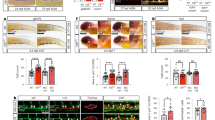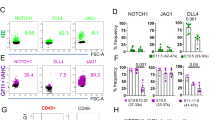Abstract
Hematopoietic stem and progenitor cells (HSPCs) are the source of all blood cells in the adult body. The pool of HSPCs is formed during embryogenesis process through a well-characterized succession of intra-embryonic regions and organs. The spatial and temporal restrictions in definitive hematopoietic development and the signaling molecules involved are of great interest as these may prove useful for generating and expanding these clinically important cell populations ex vivo. To elucidate the mechanism by which definitive HSPCs expand during this limited developmental time frame, we analyzed the spatial and temporal programmed gene expression patterns of Wnt and Notch signaling members during hematopoietic development. Genes related to the Wnt signaling pathway were up-regulated in E10.5 aorta-gonad-mesonephros (AGM) and E14.5 fetal liver corresponding to the inherent proliferation potential of hematopoietic progenitors, whereas genes related to the Notch signaling pathway were identified as up-regulated in E10.5 AGM, and bone marrow coincides with the maintenance of undifferentiation state of hematopoietic progenitors. Our findings suggest that Wnt and Notch signalings are integrated and are selectively regulating hematopoiesis. The spatial and temporal balance between Wnt and Notch signaling orchestrates the precise progression of hematopoietic progenitors.






Similar content being viewed by others
References
Graf T (2002) Differentiation plasticity of hematopoietic cells. Blood 99:3089–3101
Lum LG, Fok H, Sievers R et al (2004) Targeting of Lin-Sca+ hematopoietic stem cells with bispecific antibodies to injured myocardium. Blood Cells Mol Dis 32:82–87
Henning RJ, Burgos JD, Ondrovic L et al (2006) Human umbilical cord blood progenitor cells are attracted to infarcted myocardium and significantly reduce myocardial infarction size. Cell Transplant 15:647–658
Hicks C, Wong R, Manoharan A, Kwan YL (2007) Viable CD34+/CD133+ blood progenitor cell dose as a predictor of haematopoietic engraftment in multiple myeloma patients undergoing autologous peripheral blood stem cell transplantation. Ann Hematol 86:591–598
Nobuhisa I, Ohtsu N, Okada S et al (2007) Identification of a population of cells with hematopoietic stem cell properties in mouse aorta-gonad-mesonephros cultures. Exp Cell Res 313:965–974
Holyoake TL, Nicolini FE, Eaves CJ (1999) Functional differences between transplantable human hematopoietic stem cells from fetal liver, cord blood, and adult marrow. Exp Hematol 27:1418–1427
Nicolini FE, Holyoake TL, Cashman JD et al (1999) Unique differentiation programs of human fetal liver stem cells shown both in vitro and in vivo in NOD/SCID mice. Blood 94:2686–2695
Dzierzak E, Speck NA (2008) Of lineage and legacy: the development of mammalian hematopoietic stem cells. Nat Immunol 9:129–136
Kumaravelu P, Hook L, Morrison AM et al (2002) Quantitative developmental anatomy of definitive haematopoietic stem cells/long-term repopulating units (HSC/RUs): role of the aorta-gonad-mesonephros (AGM) region and the yolk sac in colonisation of the mouse embryonic liver. Development 129:4891–4899
Keller G, Lacaud G, Robertson S (1999) Development of the hematopoietic system in the mouse. Exp Hematol 27:777–787
Tavian M, Hallais MF, Péault B (1999) Emergence of intraembryonic hematopoietic precursors in the pre-liver human embryo. Development 126:793–803
Ema H, Nakauchi H (2000) Expansion of hematopoietic stem cells in the developing liver of a mouse embryo. Blood 95:2284–2288
Staal FJ, Clevers HC (2005) WNT signalling and haematopoiesis: a WNT–WNT situation. Nat Rev Immunol 5:21–30
Reya T, Clevers H (2005) Wnt signalling in stem cells and cancer. Nature 434:843–850
Reya T, Duncan AW, Ailles L et al (2003) A role for Wnt signalling in the self-renewal of haemapoietic stem cells. Nature 423:409–414
Austin TW, Solar GP, Ziegler FC et al (1997) A role for the Wnt gene family in hematopoiesis: expansion of multilineage progenitor cells. Blood 89:3624–3635
Murdoch B, Chadwick K, Martin M et al (2003) Wnt-5A augments repopulating capacity and primitive hematopoietic development of human blood stem cells in vivo. Proc Natl Acad Sci USA 100:3422–3427
Van Den Berg DJ, Sharma AK, Bruno E, Hoffman R (1998) Role of members of the Wnt gene family in human hematopoiesis. Blood 92:3189–3202
Nikolova T, Wu M, Brumbarov K et al (2007) Wnt-conditioned media differentially affect the proliferation and differentiation of cord-blood-derived CD133 + cells in vitro. Differentiation 75:100–111
Lako M, Lindsay S, Lincoln J et al (2001) Characterisation of Wnt gene expression during the differentiation of murine embryonic stem cells in vitro: role of Wnt3 in enhancing haematopoietic differentiation. Mech Dev 103:49–59
Kumano K, Chiba S, Kunisato A et al (2003) Notch1 but not Notch2 is essential for generating hematopoietic stem cells from endothelial cells. Immunity 18:699–711
Ohishi K, Katayama N, Shiku H et al (2003) Notch signalling in hematopoiesis. Semin Cell Dev Biol 14:143–150
Duncan AW, Rattis FM, Dimascio LN et al (2005) Integration of Notch and Wnt signaling in hematopoietic stem cell maintenance. Nat Immunol 6:314–322
Varnum-Finney B, Brashem-Stein C, Bernstein ID (2003) Combined effects of Notch signaling and cytokines induce a multiple log increase in precursors with lymphoid and myeloid reconstituting ability. Blood 101:1784–1789
Brandon C, Eisenberg LM, Eisenberg CA (2000) WNT signaling modulates the diversification of hematopoietic cells. Blood 96:4132–4141
Tickenbrock L, Hehn S, Sargin B et al (2008) Activation of Wnt signalling in acute myeloid leukemia by induction of Frizzled-4. Int J Oncol 33:1215–1221
Vijayaragavan K, Szabo E, Bossé M et al (2009) Noncanonical Wnt signaling orchestrates early developmental events toward hematopoietic cell fate from human embryonic stem cells. Cell Stem Cell 4:248–262
Witze ES, Litman ES, Argast GM et al (2008) Wnt5a control of cell polarity and directional movement by polarized redistribution of adhesion receptors. Science 320:365–369
Murphy MJ, Wilson A, Trumpp A (2005) More than just proliferation: Myc function in stem cells. Trends Cell Biol 15:128–137
Tetsu O, McCormick F (1999) Beta-catenin regulates expression of cyclin D1 in colon carcinoma cells. Nature 398:422–426
Shtutman M, Zhurinsky J, Simcha I et al (1999) The cyclin D1 gene is a target of the beta-catenin/LEF-1 pathway. Proc Natl Acad Sci USA 96:5522–5527
He TC, Sparks AB, Rago C et al (1998) Identification of c-MYC as a target of the APC pathway. Science 281:1509–1512
Weng AP, Millholland JM, Yashiro-Ohtani Y et al (2006) c-Myc is an important direct target of Notch1 in T-cell acute lymphoblastic leukemia/lymphoma. Genes Dev 20:2096–2109
Satoh Y, Matsumura I, Tanaka H et al (2004) Roles for c-Myc in self-renewal of hematopoietic stem cells. J Biol Chem 279:24986–14993
Sánchez MJ, Holmes A, Miles C, Dzierzak E (1996) Characterization of the first definitive hematopoietic stem cells in the AGM and liver of the mouse embryo. Immunity 5:513–525
Zhao Y, Lin Y, Zhan Y et al (2000) Murine hematopoietic stem cell characterization and its regulation in BM transplantation. Blood 96:3016–3022
Osawa M, Hanada K, Hamada H, Nakauchi H (1996) Long-term lymphohematopoietic reconstitution by a single CD34-low/negative hematopoietic stem cell. Science 273:242–245
Pearce DJ, Ridler CM, Simpson C et al (2004) Multiparameter analysis of murine bone marrow side population cells. Blood 103:2541–2546
Matsuzaki Y, Kinjo K, Mulligan RC et al (2004) Unexpectedly efficient homing capacity of purified murine hematopoietic stem cells. Immunity 20:87–93
Willert K, Brown JD, Danenberg E et al (2003) Wnt proteins are lipid-modified and can act as stem cell growth factors. Nature 423:448–452
Acknowledgements
We sincerely thank Prof. Axel R. Zander and Prof. Boris Fehse at University Medical Center Hamburg-Eppendorf in Germany for critical review of the manuscript. This work was supported by National Natural Science Foundation (No.30570773) and Doctoral Fund of Ministry of Education of China (No.20060487061, No.200804870008).
Author information
Authors and Affiliations
Corresponding author
Rights and permissions
About this article
Cite this article
Zhou, K., Huang, L., Zhou, Z. et al. Wnt and Notch signaling pathways selectively regulating hematopoiesis. Ann Hematol 89, 749–757 (2010). https://doi.org/10.1007/s00277-010-0923-3
Received:
Accepted:
Published:
Issue Date:
DOI: https://doi.org/10.1007/s00277-010-0923-3




